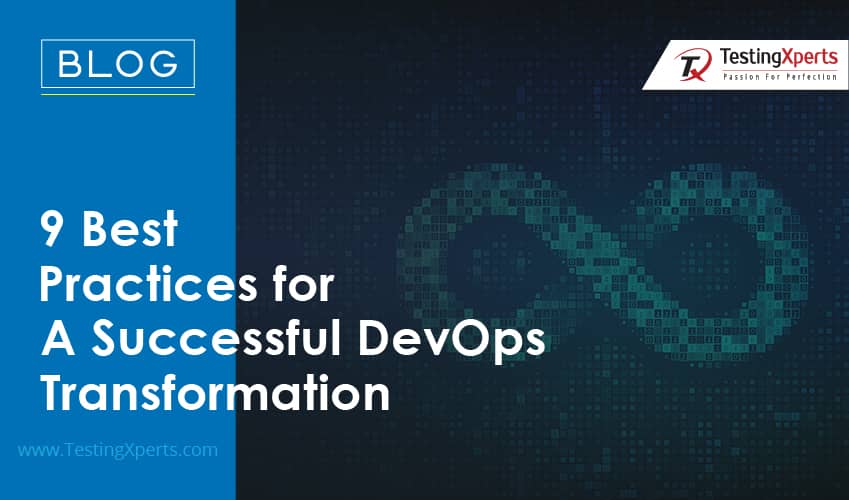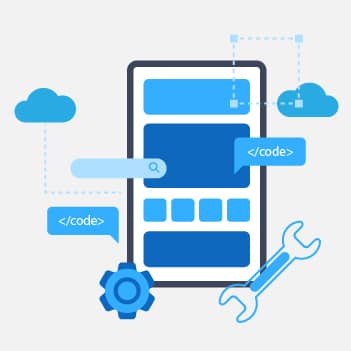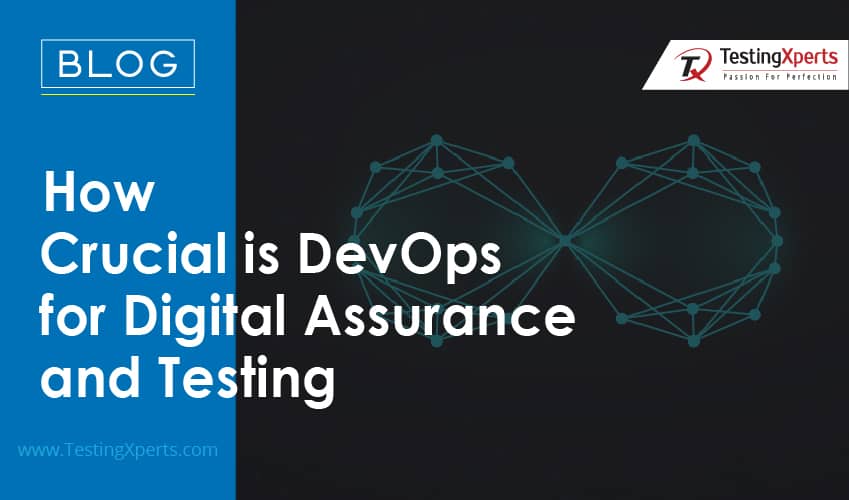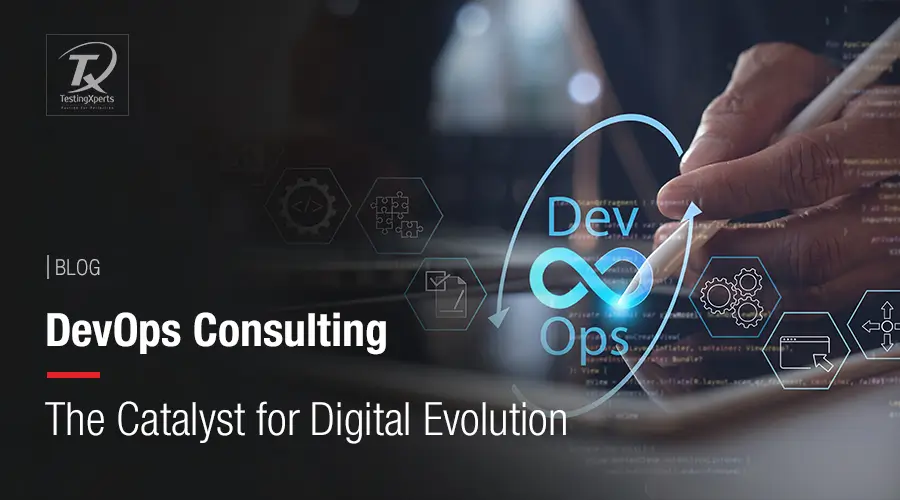
Content
1. 9 Best Practices for DevOps Transformation
1.1 Align goals with business objectives
1.2 Maximize the usage of automation tools and technology
1.3 Monitor continuously CI/CD pipelines
1.4 Measure DevOps performance continuously
1.5 Focus on the continuous feedback mechanism
1.6 Monitor proactively production environment
1.7 Go serverless to reap maximum benefits
1.8 Focus on end-user experience
1.9 Time-to-market is critical
2. Conclusion
3. Our DevOps Consulting & Implementation services
As the world is moving towards digital transformation, competition among enterprises and businesses is rising at a fast pace. Enterprises of all sizes (small, medium, and large-sized) are trying to figure out innovative ways and leverage the latest IT technology and software development methodologies to stay ahead of the competition. One such that has taken the software development life cycle (SDLC) altogether to a new shift is the most widely used agile & DevOps practices.
Typically, for enterprises to become digital-first, adopting DevOps best practices by using continuous integration and continuous delivery of software is the best and fastest way to achieve faster releases and go-to-market early.
The DevOps practices foster increased collaboration between development and operation teams, thus ensuring a better environment for faster releases as Continuous Integration (CI) and Continuous Development (CD) go hand-in-hand with the CI/CD pipelines enabled. Although many enterprises have gained immense benefits after adopting DevOps, the key to success lies in the correct implementation of DevOps practices.
Below mentioned are 9 best practices for DevOps transformation that you should consider if you are thinking of embarking on the DevOps journey.
9 Best Practices for DevOps Transformation
1. Align goals with business objectives:

People, process, and tools are three pillars that play a major role in the DevOps processes and for a successful DevOps transformation, enterprises should first identify the right stakeholders who should be involved in the process. Then identification of the right automation tools is required and then finally the processes of the enterprise should be aligned such that it matches with the objective and goals of your business.
However, it is essential to keep your stakeholders who are involved to be aware and make them get aligned in the development processes. It is a must to take necessary inputs from them and timely gather information on challenges if any for DevOps transformations.
2. Maximize the usage of automation tools and technology:

To successfully embark on a digital transformation journey, enterprises should make maximum usage of automation tools and technologies. Automation is a basic requirement for DevOps and is embedded in DevOps processes to ensure faster releases to ensure faster time-to-market. Moreover, test automation starts from the code generation stage and continues till the monitoring stage of the DevOps processes.
There are a lot of DevOps automation tools available in the market that enterprises can leverage. These automation tools help organizations to deploy applications in a much faster and efficient manner. Automation ensures accuracy, consistency, reliability, and increases the number of releases such that more features are delivered in lesser time.
3. Monitor continuously CI/CD pipelines:

Continuous monitoring of CI/CD pipelines is very important for successful enterprise DevOps transformations. Continuous monitoring helps in quick failure identification and there are many DevOps monitoring, DevOps alerting, and DevOps visualization tools that enterprises can leverage. Most of the DevOps monitoring tools work well for every infrastructure like cloud, containerized, and on-premise therefore, it ensures a smooth DevOps transformation process.
Effective use of the DevOps monitoring tools will create an efficient and strong monitoring ecosystem and will enable teams to improve the software product’s quality.
4. Measure DevOps performance continuously:

The ultimate objective of DevOps is to deliver faster to production. Therefore to validate whether or not this objective is being met, it is important to measure DevOps performance.
The four key metrics namely Lead time, Deployment frequency, Failure Rate, and Mean Time To Repair (MTTR) must be carefully monitored by enterprises to assess overall DevOps performance. These metrics altogether help determine the team’s software delivery performance and DevOps teams can experiment with the approach and can measure the impact using these performance-based metrics. These metrics push teams to focus on collaboration to achieve a common goal.
5. Focus on the continuous feedback mechanism:

Today, many enterprises are struggling to provide such software that satisfies their customer and for this, the software should be customer-centric. But how will enterprises know whether the deployed software is meeting customer expectations or not?
DevOps typically is enabled by a continuous feedback mechanism and as teams work collaboratively, various stakeholders such as product owners, QA teams, developers, and operations teams get the required information faster.
6. Monitor proactively production environment:

Enterprises need to ensure that once their teams have written the code, tested it, built it and their software gets ready to release for production, the production environment should be made ready for the release.
Evidently, if the production environment is not ready, it might act as a barrier to the success of the DevOps transformation process. Therefore, it is essential to check the preparedness of the production environment and must keep a check on the firewall configurations, backups and disaster recovery, security controls, physical and remote access, etc.
7. Go serverless to reap maximum benefits:

To realize the highest potential of DevOps, enterprises should adopt serverless infrastructure. Serverless architecture helps developers and operations teams to pay more attention to building and deploying apps instead of infrastructure management as more operations and management tasks get handled by the serverless providers.
There are various tools such as Google Cloud, AWS Lambda, Azure functions, etc. that enterprises can leverage to successfully run application code on serverless infrastructures to meet the needs of various DevOps organizations.
8. Focus on end-user experience:

Once the application is deployed it will interact with existing and new systems and therefore, make sure you keep track and focus on the end-user experience. The success of your application or service is determined by the satisfaction of these end users only. Hence, it is essential to interact with end-users at every step of the way which means after the deployment stage also and not just at the ideation or development phase.
It is essential to evaluate and understand the issues faced by users to know about their priorities which should be valued. Use this knowledge to define Key Performance Indicators (KPIs) and continuous feedback throughout the DevOps toolchain to deliver a great customer experience with high-quality solutions.
9. Time-to-market is critical:

Today’s businesses need faster and quality releases for which embracing DevOps methodology helps in going to market faster. As software evolves, new features should be released to market more frequently, and DevOps CI/CD processes along with leveraging the latest automation tools helps with faster releases and ensures to go-to-market faster.
Conclusion:
As enterprises move ahead in their DevOps transformation journey, they must remember that DevOps is not an overnight process, rather it requires a long-term commitment. The success of DevOps lies in the right way of implementation and this can be achieved by following certain best practices as mentioned in this blog. To get strategic DevOps implementation, leverage our next-gen DevOps consulting and implementation services
Our DevOps Consulting & Implementation services
Our DevOps practices include an effective methodology with an integrated approach that consists of action-based forward and backward traceability of debugging, delivery management, provisioning of resources, automation tools integration. All these are successfully taken up by our DevOps engineers and DevOps experts and ensures the below benefits to enterprises.
• Helps to implement optimized software development processes to optimize application delivery
• Ensures teams to develop quality software with assured faster releases
• Delivers improved code with better team collaboration which leads to faster time-to-production
• Ensures code quality assessments along with code security
• Delivers a pragmatic approach to your DevOps adoption
• Improves business bottom line with well-defined automation in place
• Cost optimization is assured with reduced operational costs
• Brings you best practices from the industry for successful DevOps implementations
Discover more
Get in Touch
Stay Updated
Subscribe for more info




